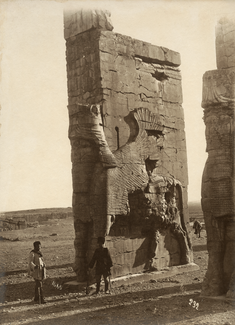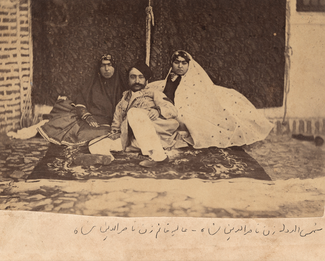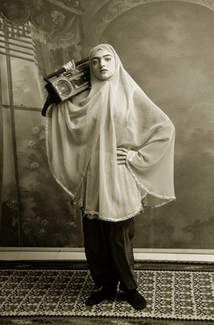Eye of the Shah: Qajar Court Photography and the Persian Past
This article first appeared in ISAW Newsletter 13, Fall 2015.
October 22, 2015 - January 17, 2016
Jennifer M. Babcock
Curatorial Postdoctoral Associate
 Colossal Winged Human-Headed Bulls of the ”Gate of All Lands” Antoin Sevruguin Photograph, H. 22.6 cm; W. 16.5cm ca. 1902–5 Collection of Azita Bina and Elmar W. Seibel
The Eye of the Shah: Qajar Court Photography and the Persian Past presents some 200 photographs taken by royal photographers engaged by Naser al-Din Shah Qajar (r. 1848- 1896), the longest reigning Shah of Iran’s Qajar Dynasty (1785-1925). The majority of these photographs have never been exhibited in the West, though the photographs were created at a time when Iran was opening itself to the Western world, and were intended to create a portrait of the country for both foreigners and Iranians themselves.
Colossal Winged Human-Headed Bulls of the ”Gate of All Lands” Antoin Sevruguin Photograph, H. 22.6 cm; W. 16.5cm ca. 1902–5 Collection of Azita Bina and Elmar W. Seibel
The Eye of the Shah: Qajar Court Photography and the Persian Past presents some 200 photographs taken by royal photographers engaged by Naser al-Din Shah Qajar (r. 1848- 1896), the longest reigning Shah of Iran’s Qajar Dynasty (1785-1925). The majority of these photographs have never been exhibited in the West, though the photographs were created at a time when Iran was opening itself to the Western world, and were intended to create a portrait of the country for both foreigners and Iranians themselves.
Naser al-Din Shah became fascinated with photography after receiving two early photographic cameras from Queen Victoria and Tsar Nicholas I while he was the crown prince of Iran. He learned how to use these cameras and became an amateur photographer himself, taking portraits of his numerous wives and capturing scenes of the royal harem. Additionally, Naser al-Din Shah hired court photographers, designated photo studios within the Golestan palace complex, and established Dar al-Fonun (the House of Arts and Sciences), where photography was formally taught.
A highlight of The Eye of the Shah is a group of unprecedented, captivating images of life in the royal court in Tehran, with subjects including the Shah, his wives and children, court entertainers, and more. In addition to photographs, there are also photograph albums exhibited, with one album containing portraits of the Shah’s wives, which were taken by Naser al-Din himself. The Shah’s adoption of Western modernizing initiatives is revealed through pictures of the military and the railway, while other photographs of shopkeepers, street vendors, and field workers portray the daily lives of the Iranian people.
 Naser al-Din Shah Qajar and Two of His Wives Reza ‘Akasbashi Albumen print, H. 12.5 cm; W. 15.9 cm ca. 1880 Kimia Foundation
Also shown are images of ancient monuments that capture the grand and eloquent beauty of such iconic Iranian sites as Persepolis, Taq-e Bostam and Naqsh-e Rostam, which were intended to evoke Iran’s rich history and to help introduce the country to the West. These photographs are complemented by European pre-photographic material, such as books and engravings dating as far back as the 16th century, to show how the West represented Iran and its ancient sites prior to the invention of photography and its introduction to Iran.
Naser al-Din Shah Qajar and Two of His Wives Reza ‘Akasbashi Albumen print, H. 12.5 cm; W. 15.9 cm ca. 1880 Kimia Foundation
Also shown are images of ancient monuments that capture the grand and eloquent beauty of such iconic Iranian sites as Persepolis, Taq-e Bostam and Naqsh-e Rostam, which were intended to evoke Iran’s rich history and to help introduce the country to the West. These photographs are complemented by European pre-photographic material, such as books and engravings dating as far back as the 16th century, to show how the West represented Iran and its ancient sites prior to the invention of photography and its introduction to Iran.
The Eye of the Shah also includes work by two modern-day Iranian photographers, incorporated into the installation. Bahman Jalali (1944-2010) is represented by photomontages created from glass-plate negatives from the Qajar Dynasty, and Shadi Ghadirian (b. 1974) by images from her series Qajar, comprising staged photographs of women that evoke the Qajar Dynasty but also include quotidian objects of modern life.
The Eye of the Shah: Qajar Court Photography and the Persian Past opens to the public on Thursday, October 22, 2015 and runs through Sunday, January 17, 2016. The exhibition is open Wednesday to Sunday from 11 to 6 pm with a late closure at 8 pm on Fridays. A free guided tour is offered each Friday starting at 6 pm.
 Untitled (#3), Qajar Series Shadi Ghadirian (Iranian, born 1974) C-print photograph H. 48.3; W. 33 cm 1998 Collection of Azita Bina and Elmar W. Seibel
The catalogue of the show, The Eye of the Shah: Qajar Court
Untitled (#3), Qajar Series Shadi Ghadirian (Iranian, born 1974) C-print photograph H. 48.3; W. 33 cm 1998 Collection of Azita Bina and Elmar W. Seibel
The catalogue of the show, The Eye of the Shah: Qajar Court
Photography and the Persian Past, will be available for sale at the
ISAW galleries.
Upcoming Exhibition: Designing Identity: The Power of Textiles in Late Antiquity
ISAW’s Spring exhibition, Designing Identity: The Power of Textiles in Late Antiquity, explores decorative motifs on textiles as indicators of social, religious, and cultural ideals for men, women, and children living in the Mediterranean World. As garments played a fundamental role in the definition and visual expression of an individual’s social status and rank, Designing Identity will feature over 50 textiles woven in different materials and decorated with diverse motifs to illuminate the complex social and cultural implications of the symbols associated with ancient costume tradition.